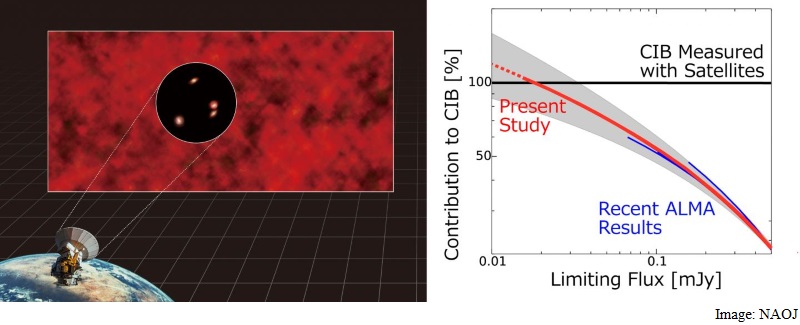Scientists Record Mysterious Infrared Light From Space
Advertisement

In a first, researchers using the Atacama Large Millimeter/submillimeter Array (ALMA) telescope have detected the faintest and mysterious infrared light ever from space.
By accumulating millimetre-waves from faint objects like this throughout the universe, the team determined that such objects were 100 percent responsible for the enigmatic infrared background light filling the universe.
By comparing these to optical and infrared images, the team found that 60 percent of them were faint galaxies whereas the rest had no corresponding objects in optical/infrared wavelengths and their nature was unknown.
Astronomers have found that there was faint but uniform light, called the "cosmic background emission", coming from all directions.
This background emission consists of three main components: Cosmic Optical Background (COB), Cosmic Microwave Background (CMB) and Cosmic Infrared Background (CIB).
Advertisement
The origins of the first two have been revealed. The COB comes from a huge number of stars and the CMB comes from hot gas just after the Big Bang.
However, the origin of the CIB was still to be solved.
Advertisement
A research team led by graduate student Seiji Fujimoto and associate professor Masami Ouchi from the University of Tokyo tackled this mysterious infrared background by examining the ALMA data archive.
They went through the vast amount of ALMA data taken during about 900 days in total looking for faint objects.
Advertisement
"The origin of the CIB is a long-standing missing piece in the energy coming from the Universe. We devoted ourselves to analyzing the gigantic ALMA data in order to find the missing piece," said Fujimoto.
Finally, the team discovered 133 faint objects, including an object five times fainter than any other ever detected.
The researchers found that the entire CIB can be explained by summing up the emissions from such objects.
ALMA detected a part of the CIB with one mm wavelengths. The CIB in millimetre and submillimetre waves does not become weak even if the source is located far away.
Therefore, this wavelength is suitable for looking through the universe to the most distant parts, the authors said.
For the latest tech news and reviews, follow Gadgets 360 on X, Facebook, WhatsApp, Threads and Google News. For the latest videos on gadgets and tech, subscribe to our YouTube channel. If you want to know everything about top influencers, follow our in-house Who'sThat360 on Instagram and YouTube.
Advertisement
